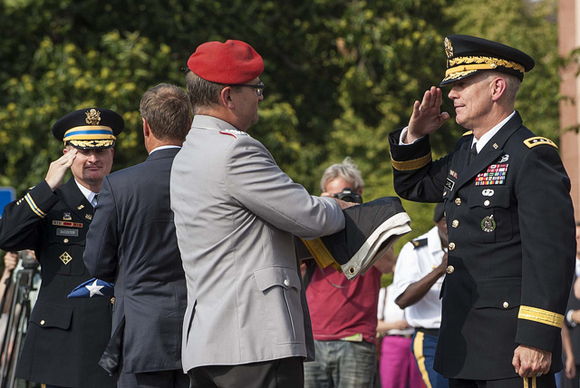 For Germans and Americans who had long imagined a dramatic coda to the cold war, it came instead in a few solemn, quiet moments. After both national anthems were played, seven American and five German soldiers lowered their national colors, marched at the edge of a bedraggled parade ground and carefully folded the flags for the last time.
For Germans and Americans who had long imagined a dramatic coda to the cold war, it came instead in a few solemn, quiet moments. After both national anthems were played, seven American and five German soldiers lowered their national colors, marched at the edge of a bedraggled parade ground and carefully folded the flags for the last time.
The ceremony on Friday afternoon, before about 300 onlookers, marked the closing of Campbell Barracks, which, as the headquarters of the United States Army in Europe, issued the orders for the millions of American soldiers — 15 million in Germany alone — who have served on the Continent since 1945. It was a day that most present, mostly an older crowd, had never imagined could come.
“We had no idea that Heidelberg will ever close,” said Regina Hingtgen, 62, who has worked with the Army for 41 years, and first honed her English when her parents billeted G.I.’s. The Army was the best employer, she said, affording her, among much else, a flexibility as a divorced single mother that “no German company would ever have done.”
The day was bittersweet, said the current commander, Lt. Gen. Donald M. Campbell Jr. — no relation to the World War II staff sergeant after whom the barracks was named —after the low-key ceremony. After the end of the cold war with the collapse of the Soviet Union, then the absorption of new NATO members and alliance commands at the base, followed by almost 10 years of preparation and a dwindling military presence, power was passing forever from Heidelberg.
The Army has shifted to a new European headquarters in Wiesbaden, where it sits atop a hill, isolated and thus secure, in this post-9/11 world, from the kind of local interactions that long made the Americans welcome here. As General Campbell noted, it is more effective to concentrate Army might in five key locations in Germany as well as in Vicenza, Italy, and in a cluster supporting NATO in Luxembourg, the Netherlands and Belgium, where NATO is headquartered.
The poignant end was a long time coming. The Berlin Wall fell almost 24 years ago, and American troops in Germany have spent more than a decade serving in Afghanistan and Iraq, or offering crucial support to those missions and others in the Horn of Africa, and much else besides. . . .
NATO left in March for a command base in Izmir, Turkey. The city of Heidelberg bid farewell in a Volksfest that drew tens of thousands of people on May 12. In the ensuing months, remaining military personnel and their families also left. . . .
Closing Heidelberg will save the Pentagon $112 million a year, mostly in costly security expenses for several scattered facilities, Mr. [Joe] Garvey said. Still, Lt. Gen. Mark P. Hertling, commander here until his retirement in November, agreed with Mr. [reporter Micha] Hörnle.
“I think a lot went lost,” General Hertling said in a telephone interview. “We Americans went into a cocoon” that was “not all that effective, truthfully,” he added, recalling German friends of troops at the Grafenwoehr base in Bavaria who wept when invited back to the base for a beer festival in 2004.
General Hertling recalled his trepidation during his first visit to Campbell Barracks, in 1975 at the age of 21, when he was a second lieutenant. Heidelberg “was the center of everything, almost like the Forbidden City to go to, because that’s where all the generals were,” he said.
When he became a commander himself, he said, he argued strongly to keep American troops in Europe — “an ocean” closer than America is to conflict in the Middle East or Africa, and working alongside allies old and new whom they knew personally. As he described the value of direct contacts with 51 European and Asian allies to skeptical members of Congress, “you could almost see the light bulbs go on,” he said.
Image: Final ceremony at Campbell Barracks in Heidelberg, Sept. 6, 2013 (photo: Staff Sgt. Brooks Fletcher/US Army)

